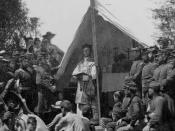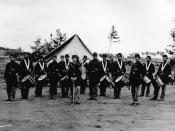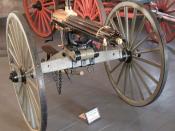For four years, American blood spilled upon the soil of the so-called "United States". The cause of this bloodshed is known as the American Civil War, which lasted from 1861 to 1865. It put family against family, and neighbor against neighbor until the newly formed country split into the North and the South. The North, also called the Union, fought to keep the country intact. The South, also called the Confederate, fought for their right to own slaves. In every war, weapons are made deadlier and faster, the Civil War was no exception. This contributed to the fact that the Civil War had more casualties than any war before in American history.
The basic weapon for infantry was the rifled musket, which was later shortened just to the
rifle. During the Civil War, to improve the accuracy of some of the weapons, spiral groves were
drilled into the muzzle of the weapon causing the bullet to spin.
Because of the spinning of the
bullet, there was less of a curve in the path of the bullet that could be caused by such things as the
wind, thus accuracy was greatly improved. The most common weapon with the groves where rifles.
Some other improvements to the rifle were the breech loading rifle and the repeating rifle. The
1861 Springfield Musket was the most often used shoulder arm and saw service in every
major battle during the Civil War. The rifle was made in the North for 15 to 20 dollars at the
Springfield Armory in Massachusetts and 32 other private manufacturers. It was considered on of
the more modern weapons used in the Civil War. The Springfield Musket's weight was around
9.25Lb, had a length of 58.5in, fires .58 calibre conical mine ball, and has a muzzle velocity of
950ft/sec. The Whitworth rifle was made by the British and used mainly by the Confederate army.
It used hexagonal shaped bullets loaded from the muzzle, had a 33in barrel and was 49in overall.
Equipped with telescopic sight, the Whitworth rifle was the best of all long range weapons used in
the war and popular among South for it's accuracy. The Spencer rifle is known to have contributed
to the victory of the Union. The magazine of the Spencer allowed rapid fire by moving the lever
and cocking the trigger. The South were unable to use many of their rifle because of their shortage
of ammunition which affected their chances of winning the war.
There were three major types of artillery used during the Civil War: guns, howitzers, and
mortars. Guns have long barrels, and fire solid projectiles at a very flat trajectory. Guns were
usually used against closely packed infantry or cavalry in direct fire and were aimed at chest height.
Howitzers were similar to the gun except it had a more arch in the path of its projectiles and were
used for shorter distances. Howitzers had a shorter barrel than a gun and needed the projectiles to
have more accuracy than velocity. Howitzers require an experience handler when firing because a
shot landing short of its target is almost useless, the shards that made up the shell of the shot can fly
about 600 yards after the shot explodes but the danger of the shards are much smaller. Mortars have
a low muzzle velocity and are unsuitable for direct fire. They're usually cumbersome artillery, and
mounted at a fixed angle that is usually between 45 to 50 degrees. It was mainly used by the Union
and has changed little since it's first use in 1453 by Ottoman Turks. The mortar was not very
accurate and the amount of gunpowder used determines the point of impact. The 1857 Gun-
Howitzer was the most popular, common, and deadly field artillery during the Civil War. It was
also know as a Napoleon. The Napoleon fires 12.3Lb projectiles with a maximum range of 1600
yards. A Union Napoleon has a swelled muzzle of 4.62in. While Confederate Napoleon has a
tapered band-reinforced breech. It is also capable of firing solid shots, shells, case rounds, and
spherical shots. The total weight of the Napoleon is 2,445Lb. Another reason the Napoleon was
favored was because of its bronze composition which is stronger and safer than iron because there
would be less chance of the gun bursting during battle and killing or wounding the crew of that
Napoleon. One of the artillery pieces developed during the Civil War was the Gatling gun. The
Gatling gun was a hand-crank operated weapon with six barrels that revolved around a central shaft.
The reason for the six shafts were to let the barrels cool partially before being used to fire again.
The cartridges were fed to the gun by gravity through the hopper mounted on the top of the gun.
The gun was capable of 600 rounds per minute, 100 rounds per minute from each barrel. The
Gatling gun wasn't a major part of the Civil War but it was the base for more successful models in
the future. Some of the problems it had was the fact that if the barrels and chambers didn't exactly
align with each other, the accuracy and velocity of the shot is reduced. And another problem was
the chamber system, the paper cartridge contained inside a capped steel chamber, was too
expensive and fragile. Even though it showed promise, like being able to fire standard .58 caliber
ammunition, there was too many flaws to interest the U.S government into buying any to be used in
the Civil War.
There were many kinds of ammunition used during the Civil War. The solid shot used for a
smooth bore weapon was simply a cast-iron spherical cannonball. For a rifled weapon, an elongated
projectile called a bolt was used. The rifle bolt was a advance technological development for the
time period. A shell was an iron projectile filled with a bursting charge of black powder. All round
shells and a few rifled shells were ignited by a time fuse. The rest of the rifled shells used
percussion caps to ignite. The case shot was and improvement on the simple shell because of the
additional small lead or iron balls attached to the interior of a thin-walled case. The balls were
embedded into sulfur or coal-tar for exploding in the air. Nearly all of them used a time fuse.
Canisters were tinned-iron cans full of lead or iron balls packed into sawdust. The effect of a
canister was like a huge shotgun blast at short range. The grape shot was similar to the canister
except there's fewer balls that were held together with iron rings or attached together with fabric
and twine. It is least issued to field and foot artillery used during the Civil War.
During the Civil War, around 620,000 men laid dead on blood soaked battlefields. Nearly
one out of four Union soldier were killed, and around 37,000 black soldiers now rest side by side
with the people that fought for and against their freedom. Almost all these deaths were caused by
the weapons they each wielded. It is inevitable that science will progress and create paths leading to
even stronger, faster, and deadlier weapons. And so each war, the number of casualties rises.


